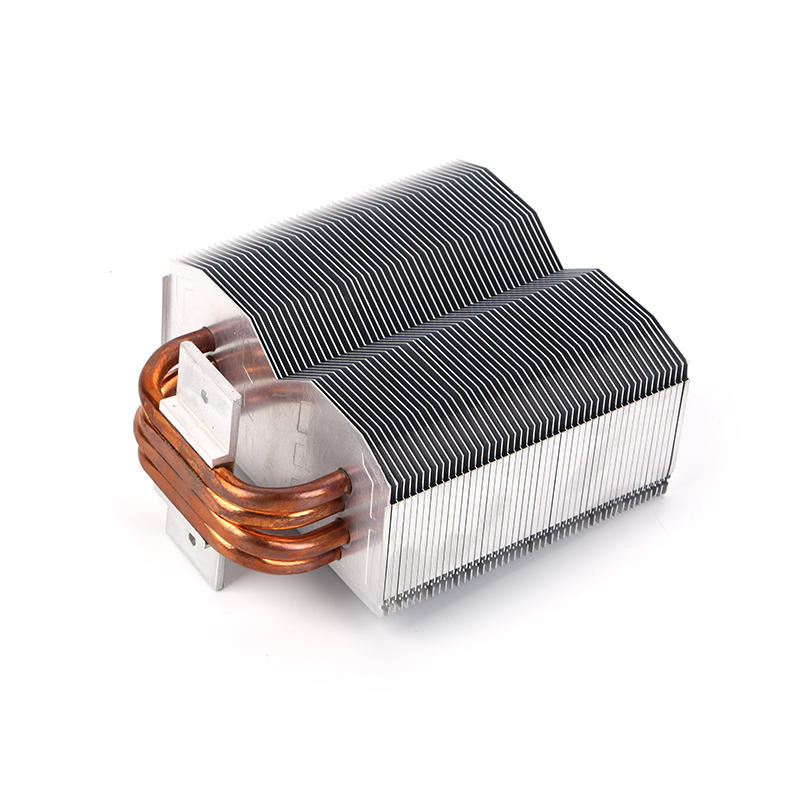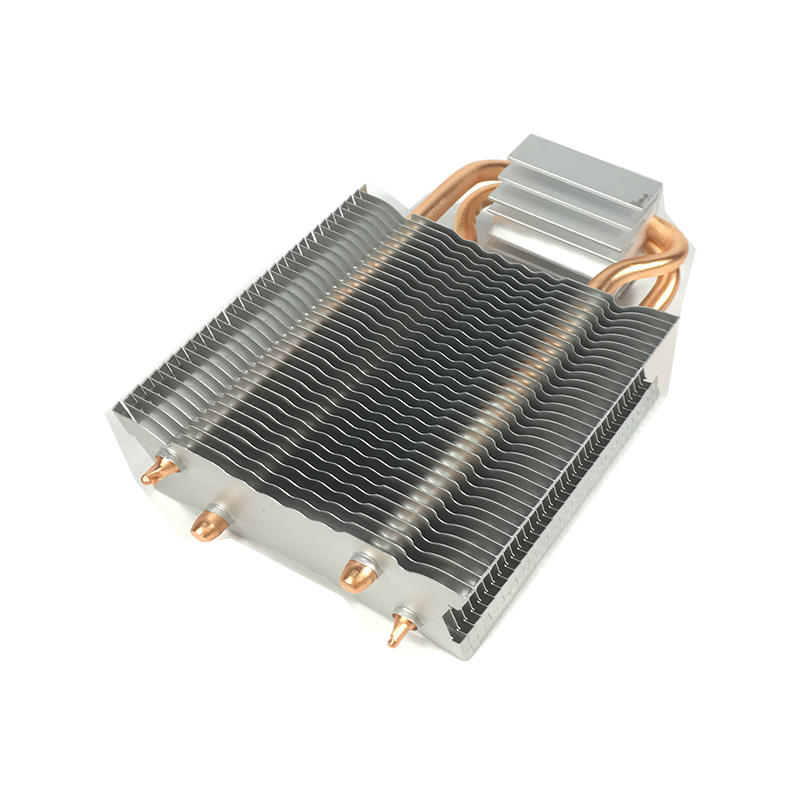Heat pipe cooling technology plays a crucial role as an efficient thermal management solution in various fields. Its core advantage lies in its unique evaporation-condensation cycle mechanism, which enables heat pipes to achieve efficient heat transfer over long distances without the need for external power. The working principle of heat pipes is based on capillary action, which allows the working fluid to circulate spontaneously inside the heat pipe, facilitating rapid heat transfer. In modern industries, with the continuous improvement in the performance of electronic devices, the demand for heat dissipation is also increasing. Heat pipes, due to their high thermal conductivity and compact structural design, have become an ideal choice for addressing overheating issues in electronic devices. Furthermore, heat pipe cooling technology also has wide-ranging applications in energy and environmental engineering, aerospace, and other fields. This article will delve into the basic principles of heat pipe cooling technology, analyze the material selection and design requirements of its key components, and explore how to enhance the performance of heat pipe cooling systems by optimizing the working process. Additionally, this article will introduce practical application cases of heat pipe cooling technology in different fields, as well as forecast its future development trends and potential technological innovation directions. Through elucidating these contents, the aim is to provide engineers and researchers with a comprehensive and in-depth technical reference on heat pipe cooling technology.
Heat pipe cooling technology is a heat transfer device that efficiently transfers heat using an evaporation and condensation cycle. Its working principle is based on two fundamental processes: capillary action and phase-change heat transfer. Within the enclosed space of the heat pipe, the working fluid absorbs heat at the heating end, evaporates into vapor, then flows to the cooling end where it condenses into liquid at lower temperatures, releasing heat. The condensed liquid returns to the heating end through capillary structures, completing the cycle and enabling continuous heat transfer.

Capillary action is the key driving force for internal circulation within the heat pipe, arising from surface tension effects generated by the micro-geometric shapes of capillary structures inside the heat pipe. This action allows the working fluid to overcome gravity and other resistances, flowing from the heating end to the cooling end. The design of capillary structures is crucial for the performance of heat pipes, with common structures including porous bodies, grooves, and fiber networks.
During the operation of heat pipes, the flow of vapor generates pressure differences, directly affecting the heat transfer capacity of the heat pipe. The design of heat pipes must ensure that the pressure drop during the internal flow of vapor and condensed liquid remains within a reasonable range to avoid excessive flow resistance. Additionally, thermal resistance and temperature gradients are also important factors affecting their performance. Thermal resistance mainly originates from the fill volume of the working fluid, the thermal conductivity of capillary structures, and the thermal conductivity of the shell material. Temperature gradients are related to the heat flux density of the heat source, the operating temperature range of the heat pipe, and cooling conditions.
The operating characteristics of heat pipes also include their heat transfer efficiency, heat capacity, and thermal inertia. Heat transfer efficiency refers to the ability of the heat pipe to transfer heat within a unit of time, closely related to its design and operating conditions. Heat capacity reflects the heat storage capacity of the heat pipe, while thermal inertia describes the response speed of the heat pipe to changes in heat flux. These characteristics enable heat pipes to provide flexible and efficient cooling solutions in various thermal management applications.
The basic principles of heat pipe cooling technology involve complex physical phenomena and engineering issues. The realization of its efficient heat transfer capabilities depends on the precise control and optimization of key factors such as capillary action, phase-change heat transfer, pressure differences, thermal resistance, and temperature gradients. Through a deep understanding of these principles, scientific foundations can be provided for the design and application of heat pipes, thereby promoting their widespread application and development in various fields.
The performance and reliability of heat pipes largely depend on the design of their key components and the selection of materials. Heat pipes mainly consist of three parts: the shell, working fluid, and capillary structure.
The shell is the external structure of the heat pipe, typically responsible for supporting the internal capillary structure and working fluid, while also providing physical protection and thermal isolation. The selection of shell materials needs to consider their thermal conductivity, mechanical strength, corrosion resistance, and processability. Common shell materials include copper, aluminum, stainless steel, etc., with copper widely used in the design of high-performance heat pipes due to its excellent thermal conductivity. Aluminum is applied in lightweight heat pipes due to its lower density and cost-effectiveness. Stainless steel has advantages in harsh environments due to its good corrosion resistance and high-temperature resistance.
The working fluid is the medium responsible for the internal circulation within the heat pipe, absorbing and releasing heat. The selection of the working fluid has a significant impact on the start-up performance, operating temperature range, and heat transfer efficiency of the heat pipe. An ideal working fluid should have high latent heat of vaporization, low viscosity, good thermal stability, and chemical stability. Common working fluids include water, ethanol, ammonia, and various low-toxicity organic compounds. When selecting a working fluid, its compatibility with the shell material should also be considered to prevent corrosion and leakage.
The capillary structure is the core component inside the heat pipe, and its design directly affects the capillary action and heat transfer efficiency of the heat pipe. Capillary structures come in various forms, including porous bodies, grooves, and fiber networks. Porous body structures are typically sintered from metal powders, exhibiting good capillary action and a high retention rate of working fluid. Groove structures are formed through precision machining, allowing for finer liquid distribution and control. Fiber network structures utilize capillary pressure generated by the contact between capillary fibers, offering high capillary pressure and excellent heat transfer performance. The materials of capillary structures should have good wettability and chemical stability to ensure long-term stable operation of the heat pipe.
Through careful design and selection of suitable materials, the key components of heat pipes can work together to achieve efficient heat transfer and stable operational performance. This is crucial for the critical role played by heat pipes in various high-demand thermal management applications.
Heat pipe cooling technology has been widely used in many fields due to its efficient heat transfer capabilities and compact design. The following are the specific applications of heat pipe cooling technology in different fields.
As electronic device performance continues to improve, heat dissipation becomes a critical factor limiting its performance. Heat pipe cooling technology plays an important role in the field of electronic device heat dissipation. For example, in the heat dissipation systems of computer CPUs and GPUs, heat pipes effectively transfer heat from the heat source to the heat sink, achieving rapid heat dissipation by increasing the surface area for heat dissipation. Additionally, heat pipe technology is widely adopted in thermal management systems for communication base stations and data centers to ensure stable operation of devices under high heat loads.
In energy and environmental engineering, heat pipes are used as efficient energy transfer components in solar collectors. Heat pipes can rapidly transfer the heat obtained from solar energy to thermal storage systems or directly for heating and hot water purposes. Additionally, in industrial waste heat recovery systems, heat pipes also play a crucial role. Through the efficient heat transfer characteristics of heat pipes, waste heat generated during industrial processes can be recovered and utilized for heating or other thermal energy requirements, thereby improving energy utilization efficiency and reducing environmental pollution.

In the aerospace field, heat pipe cooling technology is used in the temperature control systems of satellites and spacecraft. Due to the drastic temperature changes in outer space, heat pipes can effectively transfer the heat generated inside the spacecraft to external radiators, maintaining the normal operating temperature of internal equipment. Additionally, in the cooling systems of rocket engines, heat pipes also play a crucial role in protecting engine components from overheating damage, thereby extending their operational lifespan.
In addition to the aforementioned sectors, heat pipe cooling technology is widely applied in several other fields such as automotive, medical equipment, LED lighting, and laser cooling.
In the automotive industry, heat pipes are used for cooling battery packs and engine components.
In the medical equipment sector, heat pipes are utilized to maintain stable temperatures in devices, thereby enhancing treatment effectiveness and device longevity.
Within LED lighting systems, heat pipes aid in effectively dissipating heat from LED chips, thus improving luminous efficiency and lifespan.
Regarding laser cooling, heat pipes ensure that lasers maintain stable temperatures during high-power output, guaranteeing the quality and stability of laser output.
In summary, heat pipe cooling technology has a wide range of applications, and its efficient and reliable heat transfer performance has been fully utilized and verified in various fields. With the continuous development and optimization of heat pipe technology, its application in modern industry and technology fields will become more in-depth and extensive.
Heat pipe cooling technology has shown great application potential and value in many fields due to its excellent heat transfer efficiency and compact design. With the continuous advancement of science and technology and the growing industrial demand, heat pipe technology is also constantly developing and improving. Future development trends are mainly reflected in the following aspects:
Innovation in Materials and Manufacturing Technology
With the development of new materials and advancements in manufacturing technology, the performance of heat pipes will be further enhanced. For instance, utilizing high thermal conductivity materials and advanced nanotechnology can manufacture more efficient and lightweight heat pipes. Additionally, the development of novel synthetic working fluids will help broaden the operating temperature range of heat pipes, meeting the thermal management needs in special environments.
Design Optimization and Performance Enhancement
The optimization of heat pipe design is key to improving its performance. By employing advanced Computational Fluid Dynamics (CFD) simulations and optimization algorithms, the internal capillary structures and working fluid distribution of heat pipes can be designed more accurately, achieving higher heat transfer efficiency and lower thermal resistance. Moreover, through modular and integrated design, heat pipe cooling systems will become more flexible and efficient.
Expansion of Application Areas
The application areas of heat pipe cooling technology will continue to expand. In addition to existing fields such as electronic device cooling, energy and environmental engineering, aerospace, etc., heat pipe technology is also expected to be applied in emerging fields such as new energy, biomedicine, marine engineering, etc. For example, in the field of new energy, heat pipes can be used for thermal energy storage and transfer in solar thermal power plants; in the biomedical field, micro heat pipes can be used for precise temperature control in medical devices.
Environmental Friendliness and Sustainable Development
With the increasing global emphasis on environmental protection and sustainable development, heat pipe cooling technology will also trend towards environmentally friendly development. Researchers will strive to develop non-toxic, low environmental impact working fluids and materials, while also improving the energy efficiency of heat pipes to reduce energy consumption. Additionally, lifecycle assessment and recycling of heat pipe technology will receive more attention.
The future development prospects of heat pipe cooling technology are bright. Through continuous technological innovation and application expansion, heat pipe technology will play a more important role in improving energy efficiency, saving energy and reducing emissions, and promoting sustainable development.
By continuing to use the site you agree to our privacy policy Terms and Conditions.